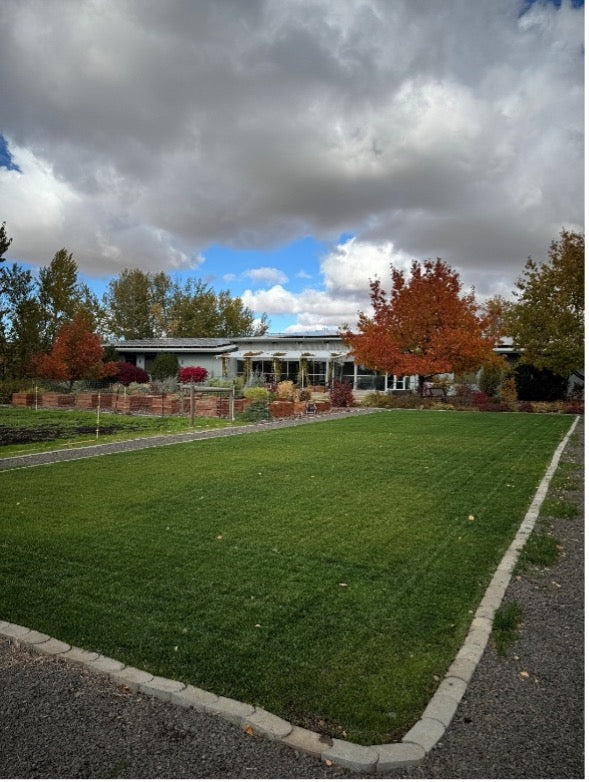I always feel like the answer to this question is ultimately a game-time decision, especially if you enjoy the mow as much as I do. There are certainly indicators however, such as soil temperatures, but each lawn, microclimate, and individual preference will ultimately dictate which mow is the final mow. In general, DIYers should plan to stop mowing when their lawn stops growing, usually as soil and air temperatures consistently dip below 50°F (10°C) for cool season lawns and below 55°F (13°C) for warm season turf. These temperature thresholds signal a shift toward dormancy, after which additional mowing can cause stress to your turfgrass. It’s important to note that these are generalizations and that certain turfgrass species and cultivars may go dormant sooner or may continue to grow for longer into the fall based on their genetics.
Why Mowing Changes In Fall
Grass growth is highly temperature-dependent, relying on metabolic activity that slows as days get cooler and daylight shortens. Cool-season grasses (Kentucky bluegrass (Poa pratensis), perennial ryegrass (Lolium perenne), and turf type tall fescue (Festuca arundinacea)) stay active later into autumn, sometimes requiring a final cut in late October or early November, just before the first hard frost. Warm-season grasses (Bermudagrass (Cynodon dactylon), Zoysia (Zoysia japonica), and St. Augustine (Stenotaphrum secundatum)) transition earlier, turning brown and dormant as temperatures drop below 55°F (13°C).

Image #1. Late October Lawn in Zone 7a. Still being mowed once per week, average soil temperature over the past week = 51 F
Making The Final Cut
The final mow is an opportunity to set your grass up for winter resilience. Lower your height of cut for the last several cuttings; my preference is to lower the height of cut by about 20% coming into winter. I do this gradually across two to three mowings. This would mean if you were mowing at 4 inches, drop it down to ~3.25 inches or if you were mowing at 3 inches, reduce to 2.5 inches. Shorter grass better resists matting, snow mold, and fungal disease formation under snow cover. Be sure to clear debris and leaves regularly, which can suffocate grass and create disease risk if left over winter.

Signs It’s Time to Stop Mowing
- Grass growth slows dramatically and mowing yields almost no clippings.
- Daytime temperatures and soil temperatures remain below 50°F (10°C) for a week or more.
- The lawn shows signs of dormancy: dull color, slowed recovery, and reduced vigor.
- Heavy and regular frost appears signaling the turf's shift into winter dormancy.
Regional Differences
- Northern regions/Cool Season Zone: Mowing can end as early as October; first hard frost and lack of clippings is the cutoff.
- Transition Zone: Warm-season lawns will often go dormant sooner, sometimes by late September or early October.
- Southern region/Warm Season Zone: Lawns will often not enter dormancy until December.
- Lawns in certain microclimates may remain green and growing for longer and need mowing a bit deeper into fall.

Image #3: Approximation of the distribution of each zone.
Lawn Dormancy Explained
Dormancy is a stress-response mechanism. When turf perceives prolonged cold, it stops photosynthesizing and shifts energy away from blade growth into root and crown protection. This survival strategy helps lawns resist winter injury and drought but means growth halts until spring soil warms. It's notable to mention that dormancy doesn’t operate like a light switch and get immediately turned on and off; it is a gradual process over weeks or a month or so, so you may see a mottled or blotchy appearance as this occurs in your lawn.
Final Tips for DIYers
- Don’t mow when the grass is wet, frozen, or covered in frost, this damages plants.
- Service your mower after the last cut so it’s ready for spring.
- Aerate your lawn in the fall if you can; it will improve drainage and root health.
Proper timing of your last mow sets the stage for a healthy green-up when spring arrives, giving DIYers a true science-driven edge.

Share:
Keep Off Frosty Turf: Protecting Your Lawn and Garden in Cold Weather